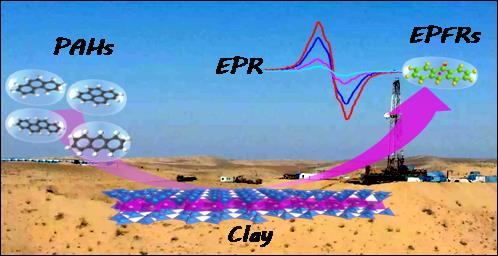Scientists Uncover Formation Mechanism of Environmentally Persistent Free Radicals in PAHs-contaminated Soil
Editor: | Aug 30,2016
Polycyclic aromatic hydrocarbons (PAHs) are produced worldwide via fossil fuel deposit and incomplete combustion. PAHs are considered as one class of primary contaminants in naturally hydrophobic phases such as soil and sediment. However, limited work has been conducted to assess the formation of PAHs-induced free radicals and their persistence on clay surfaces, and thus critical information is missing for the evaluation of potential risks from PAHs contaminated soil in association with environmentally persistent free radicals (EPFRs).
EPFRs have been detected in PAHs-contaminated soil under ambient environmental conditions. A research team led by Prof. WANG Chuanyiat Xinjiang Technical Institute of Physics and Chemistry(XTIPC)of Chinese Academy of Sciences found the formation mechanism of EPFRs induced by PAHs on Fe3+-clay surface.
Researchers used electron paramagnetic resonance (EPR) analysis to detect conversion of molecular PAHs to EPFRs as well as persistency of the EPFRs. By selecting four PAHs, that is, phenanthrene, anthracene,benzo[a]pyrene and pyrene, they found persistent free radicals can only be observed on Fe(III)-montmorillonite contaminated by anthracene, and other three PAHs didn’t show any detectable EPR signals.
PAHs transformation and EPFRs formation are similar to the mechanism proposed in previous studies, which due to the electron transfer process between PAHs and surface cations. In order to further understand the mechanism of EPFRs formation, the initial Fe(III) impact on the anthracene process is modeled by the transformation state theory.
Researchers found that electron transfer between anthrone and Fe(III)-montmorillonite induces the formation of anthrone-type radical, followed by hydrolysis to generate oxanthrone, which can be further transformed to anthraquinone. Moreover, they identified more than one type of organic radicals including anthracene-based radical cations and oxygenic carbon-centered radicals.
Overall, researchers discovered that the formed EPFRs are stabilized by their interaction with interlayer surfaces, and such surface-bound EPFRs exhibit slow decay with 1/e lifetime of 38.46 days.
The work was supported by the National Natural Science Foundation of China, the West Light Foundation of Chinese Academy of Sciences, etc.

Figure: Formation of EPFRs on PAHs-contaminated soil (Image by XTIPC)
Contact:
Prof.WANG Chuanyi
E-mail: cywang@ms.xjb.ac.cn
Xinjiang Technical Institute of Physics & Chemistry,CAS
附件下载:
 (86) 991-3838931
(86) 991-3838931 lhskj@ms.xjb.ac.cn
lhskj@ms.xjb.ac.cn (86)991-3838957
(86)991-3838957 40-1 Beijing Road
Urumqi, XinjiangChina
40-1 Beijing Road
Urumqi, XinjiangChina